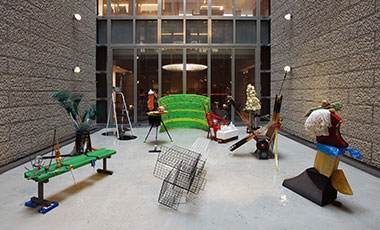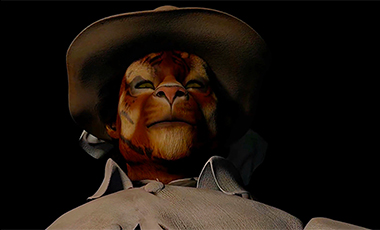In the NovemberArt Talk, we review the 《Deoksugung Project》 (2012.9.19.~12.2, Deoksugung Palace), which has brought a nation-wide sensation through the encounter between Deoksugung and Korean contemporary art. At every place in Deoksugung which has various time layers as a historical site, this art project exhibits various works of Korean contemporary art by diverse creators from diverse fields such as artists, dancers, and so on. As far as the Art Talk is a comer that proposes diverse points of view through cross-criticisms by diverse experts from various fields, we reviewed this project and art works this time with peculiar aspects of diverse critics of various fields, including the curator of the project.
《Deoksugung Project》: The Calling of Memory
In Deoksugung, sorrow has left with its tragic history at the time of enlightenment of Korea. In comparison with its monumental position as the place of proclamation of Daehan Empire although smaller than Gyungbokgung, the Royal Palace of Chosun Dynasty, the foreign influences engraved all over in places looks as if they testifies the urgent situations at that time. As a matter of fact, the Seokjojeon with western style and Jeonggwanheon’s mixed style of East and West are in particular sorrowful legacy in contrast to their splendid appearances. The materials utter nothing but keep the lost time with silence instead. The reason that we can recollect such stealthful memories from the materials might attribute to the fact that the spirit dwell in the abstractness of the materials. Nevertheless, not all people seem to be able to recall these memories by watching a legacy, the Deoksugung, because every individual has different limitation in interpreting the reality through their own viewpoints, experiences, and sensibilities. The 《Deoksugung Project》 is a cultural project that was planned to talk to us about the abstract memories inherent in the place and materials through multiple methods. Interpreted with plural artistic languages in art, music, design, drama and dance, the dramatic situation at the time of Korea’s enlightenment refreshes historical events carved deep inside of six palaces and backyards within this place.
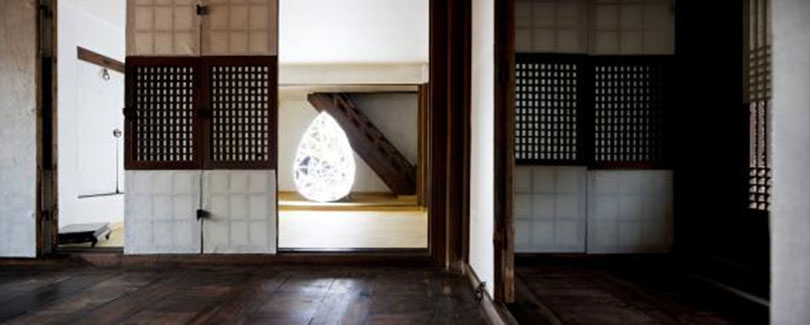 Yeesookyung_Seogeodang, Tear Drop_National Museum of Contemporary Art Korea, Commission_2012
Yeesookyung_Seogeodang, Tear Drop_National Museum of Contemporary Art Korea, Commission_2012
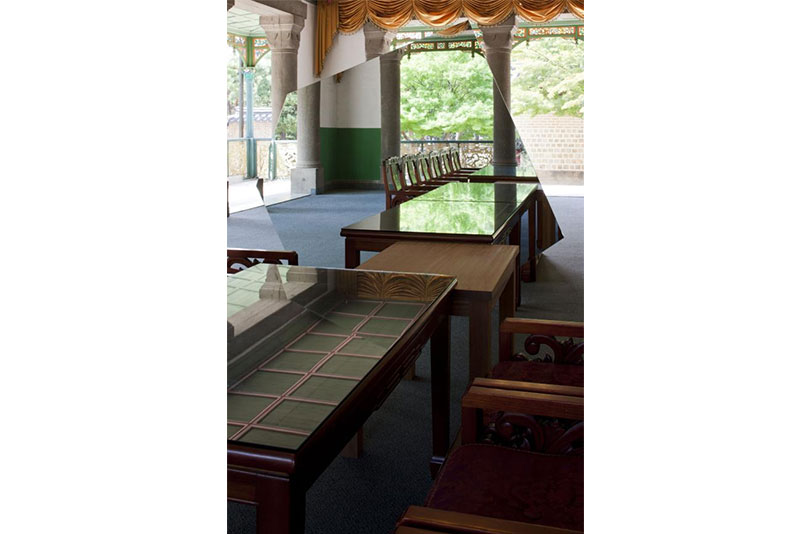 Chung Seoyoung_Jeonggwanheon, Inwardly, Determine Yourself, National Museum of Contemporary Art Korea, Commission, 2012
Chung Seoyoung_Jeonggwanheon, Inwardly, Determine Yourself, National Museum of Contemporary Art Korea, Commission, 2012
Yeesookyung’s 'Tear Drop' installed in Seogeodang is a metaphor of the sad history that this place keeps. The work in the shape of tear drop made with reflecting materials and LED illumination emits lights like a huge jewel. Seogeodang is a place conceived with sorrow. The palace initiated its history with the King Sunjo’s stay after his returning from the refuge by the Japanese’ invasion of Korea in 1593, and the King died here. Yeesookyung’s tear drop sculpture seems to be the figuration of the tragic future of the Deoksugung that was born under the critical situation of history. Decorated with Oriental patterns and the icons of the Daehan Empire, the Jeonggwanheon in East-European style is famous for the fact that the King Gojong enjoyed drinking coffee. Chung Seoyoung stirs up the viewers’ gazes by the rearrangement of the interior furnitures and by the installation of multi-angular, double-faced mirror. Her artistic work does not operate as a reference but is frequently used as a mechanism that changes the viewers’ psychological status in usual situations. The intervention of the mirror looks like the external pressure, and the image reflected on it seems to emphasize the contradiction of the historical conception. It is because the history is mostly made up from the discontinuation of the past by subversions, which also makes the succession of the history. Inside of the Deokhongjeon, originally Gyunghyojeon which enshrine the Empress Myeongsung’s ancestral tablet but remodelled in 1912 after the Japanese annexation of Korea, there is a sitting chair installed by Ha Jihoon, a furniture designer. Filling the whole space of the room, the artist’s chrome-gilded chair brings up the image of the curving lines of a body doing obeisance. Japanese rulers remodelled this sanctified place and used as a reception room after decorated it flamboyantly. As if appealing the unfairness of that time, the chair contains the pathetic and the mysterious like the figure of the departed soul invited to a memorial service.
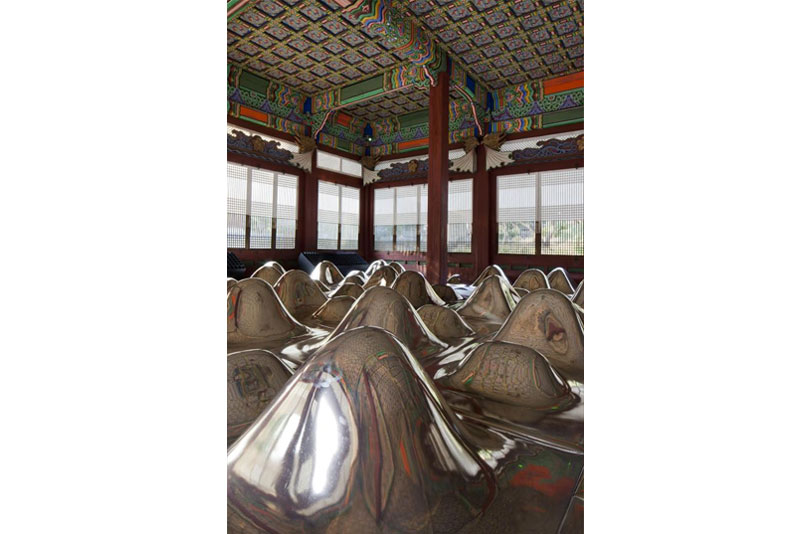 Ha Jihoon_Deokhongjeon, Jari_National Museum of Contemporary Art Korea, Commission, _2012 (Sound: Sung Kiwan)
Ha Jihoon_Deokhongjeon, Jari_National Museum of Contemporary Art Korea, Commission, _2012 (Sound: Sung Kiwan)
The artists invited to this project seem rather to be magicians who call back transcendent memories through symbols and metaphors than historians who introduce the turning point of modern era. It must be a painful work for both artists and viewers to recall traumatic memories, but the calling of the contemporary artists might be not only to ruminate over the wounds. With this point of view, the 《Deoksugung Project》 seems to have well exhibited an attitude to transit the substantial nature of history into the present time instead of a place of history documented out of the Deoksugung’s identity as a park within the center of a town. This must be a cornerstone to solidify its ground for expanding history as a basic compound for further artistic creations and seeking for various cultural possibilities of historical sites. What is important here lies on the expansion of the 《Deoksugung Project》 toward being continuously an arena of innovative and creative experiments instead of being stopped at this standpoint. Because nothing more than the multilateral attempts to breathe with this very contemporary life out of being remained within the views of historicity, could be proposed for the historical sites of the past as the possibility of the future beyond the present.
Deoksugung Project viewed by 6 people
The inside of time in the eternal rest _ Gu Na-yeon(Art Critic)
I want to go further back in time _ Kim, So-yeon(Theater critic)
《Deoksugung Project》: Contemporary Interpretation on Legacy _ Kim Inhye(Curator, National Museum of Contemporary Art Korea )
《Deoksugung Project》: To get over the Sadness to Pieces _ Sun Seunghye(Professor, Sungkyunkwan University)
《Deoksugung Project》: Reconciliation between Crash of Time and Scenography _ Kim Namsoo(Choreography Critic)

Jung Hyun / Art Critic, Independent Curator
Jung Hyun is an art critic and independent curator based in Seoul. He is currently professor at Inha University. As an Independent curator he has produced Bonjour, Mr. Courbet(2010), Public art project E+Motion Sabuk and Gohan(2009), Rogues, Image of Others(2008). He also contributes regularly for art magazines in Korea. He received his PhD degree from the University Paris I, Pantheon-Sorbonne.

